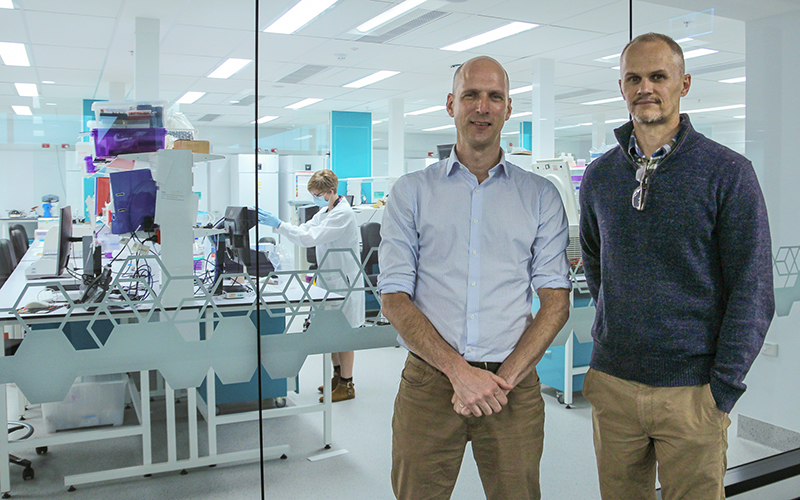Reports and Findings
Research
Western Australian health care workers’ views on mandatory COVID-19 vaccination for the workplaceHealth care workers (HCWs) are at an increased risk of catching and spreading Coronavirus Disease 2019 (COVID-19) compared with the general community, putting health systems at risk. Several jurisdictions globally have mandated or are looking to mandate COVID-19 vaccines for this cohort, but little is known about the acceptability of this measure, especially in different contexts, and there is little qualitative data to explore nuance, depth, and the reasons behind HCWs’ opinions.

Research
Setonix Pharmaceuticals: Enhancing immuno-oncology with small molecule drugsSetonix Pharmaceuticals aim to develop orally available immunotherapy drugs that are optimally effective with minimal side effects, improving outcomes for cancer patients.
Research
Dysphagia in laryngomalacia: a prospective cohort studyDysphagia is an under recognised co-morbidity in patients with laryngomalacia. Its rate is variable reported in the literature. We aim to describe the incidence of dysphagia in laryngomalacia, the effect of interventions on this, and the period it persists in these infants.
Research
Epidemiology of Neonatal Acute Respiratory Distress Syndrome: Prospective, Multicenter, International Cohort StudyAge-specific definitions for acute respiratory distress syndrome (ARDS) are available, including a specific definition for neonates (the "Montreux definition"). The epidemiology of neonatal ARDS is unknown. The objective of this study was to describe the epidemiology, clinical course, treatment, and outcomes of neonatal ARDS.
Research
Less is more: repellent-treated fabric strips as a substitute for full screening of open eave gaps for indoor and outdoor protection from malaria mosquito bitesProviding protection from malaria vector bites, both indoors and outdoors, is crucial to curbing malaria parasite transmission. Screening of house entry points, especially with incorporated insecticides, confers significant protection but remains a costly and labour-intensive application. Use of spatial repellents has shown promise in creating areas of protection in peri-domestic areas.
Research
A novel skin cancer prevention strategy: Preservice teachers' perceptions of a sun safety intervention and experiences in schoolsTeachers play a vital role in developing children's sun protection routines however upskilling preservice teachers (PSTs) while at university has not yet been trialled as a targeted skin cancer prevention strategy. Hence, this study investigated PSTs perceptions and experiences of sun safety following a brief pilot intervention and placement in primary schools in Western Australia.
Research
Rift Valley fever seropositivity in humans and domestic ruminants and associated risk factors in Sengerema, Ilala, and Rufiji districts, TanzaniaData on Rift Valley fever virus (RVFV) prevalence in urban settings and pastoral areas of Tanzania are scarce. We performed a cross-sectional study of RVFV seroprevalence and determinants in humans and animals from Ilala, Rufiji, and Sengerema districts of Tanzania.
Research
ERS/ATS technical standard on interpretive strategies for routine lung function testsAppropriate interpretation of pulmonary function tests (PFTs) involves the classification of observed values as within/outside the normal range based on a reference population of healthy individuals, integrating knowledge of physiological determinants of test results into functional classifications and integrating patterns with other clinical data to estimate prognosis.
Research
Isoelectric Electroencephalography in Infants and Toddlers during Anesthesia for Surgery: An International Observational StudyIntraoperative isoelectric electroencephalography (EEG) has been associated with hypotension and postoperative delirium in adults. This international prospective observational study sought to determine the prevalence of isoelectric EEG in young children during anesthesia.
Research
In vitro antibacterial activity of Western Australian honeys, and manuka honey, against bacteria implicated in impetigoImpetigo is a contagious skin disease caused by Staphylococcus aureus and Streptococcus pyogenes. Without treatment, impetigo may be recurrent, develop into severe disease, or have serious, life-threatening sequelae. Standard treatment consists of topical or systemic antibiotic therapy (depending on severity), however, due to antibiotic resistance some therapies are increasingly ineffective.
